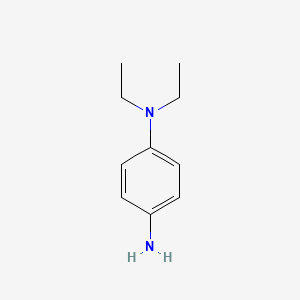D1007 | n,n-diethylbenzene-1,4-diamine
| Toxicity | Dose | Time | Species | Model | Method | Action | Positive criterion | Reference |
|---|---|---|---|---|---|---|---|---|
| MEMBRANE POTENTIAL | 49.89±3.51 | human | qHTS-HepG2 | MMP assay | decrease | IC50 | 163 | |
| MEMBRANE POTENTIAL | 7.94 | human | HepG2 | MMP assay | decrease | IC50 | 163 | |
| MEMBRANE POTENTIAL | 31.62±0.00 | rat | hepatocytes | MMP assay | decrease | IC50 | 163 | |
| Pictogram | Signal | Statements | Precautionary Statement Codes |
|---|---|---|---|
  |
Danger |
H301: Toxic if swallowed [Danger Acute toxicity, oral] H314: Causes severe skin burns and eye damage [Danger Skin corrosion/irritation] |
P260, P264, P270, P280, P301+P310, P301+P330+P331, P303+P361+P353, P304+P340, P305+P351+P338, P310, P321, P330, P363, P405, and P501; (The corresponding statement to each P-code can be found at the GHS Classification page.) |
  |
Danger |
Aggregated GHS information provided by 44 companies from 2 notifications to the ECHA C&L Inventory. Each notification may be associated with multiple companies. H301 (100%): Toxic if swallowed [Danger Acute toxicity, oral] H314 (100%): Causes severe skin burns and eye damage [Danger Skin corrosion/irritation] Information may vary between notifications depending on impurities, additives, and other factors. The percentage value in parenthesis indicates the notified classification ratio from companies that provide hazard codes. Only hazard codes with percentage values above 10% are shown. |
P260, P264, P270, P280, P301+P310, P301+P330+P331, P303+P361+P353, P304+P340, P305+P351+P338, P310, P321, P330, P363, P405, and P501; (The corresponding statement to each P-code can be found at the GHS Classification page.) |
  |
Danger |
H301: Toxic if swallowed [Danger Acute toxicity, oral] H314: Causes severe skin burns and eye damage [Danger Skin corrosion/irritation] |
P260, P264, P270, P280, P301+P310, P301+P330+P331, P303+P361+P353, P304+P340, P305+P351+P338, P310, P321, P330, P363, P405, and P501; (The corresponding statement to each P-code can be found at the GHS Classification page.) |
  |
Danger |
H301: Toxic if swallowed [Danger Acute toxicity, oral] H317: May cause an allergic skin reaction [Warning Sensitization, Skin] |
P261, P264, P270, P272, P280, P301+P310, P302+P352, P321, P330, P333+P313, P363, P405, and P501; (The corresponding statement to each P-code can be found at the GHS Classification page.) |
| Organism | Test type | Route | Dose (normalized dose) | Effect | Source |
|---|---|---|---|---|---|
| guinea pig | LD50 | skin | > 1gm/kg (1000mg/kg) | Kodak Company Reports. Vol. 21MAY1971, | |
| rat | LD50 | oral | 200mg/kg (200mg/kg) | Kodak Company Reports. Vol. 21MAY1971, | |
| rat | LDLo | intraperitoneal | 25mg/kg (25mg/kg) | Kodak Company Reports. Vol. 21MAY1971, | |
| mouse | LD50 | intravenous | 24mg/kg (24mg/kg) | U.S. Army Armament Research & Development Command, Chemical Systems Laboratory, NIOSH Exchange Chemicals. Vol. NX#07893, | |
| (4-aminophenyl)-diethyl-amine | (4-aminophenyl)diethylamine | 0QQA4DFV2J |
| 1,4-Benzenediamine, N,N-diethyl- | 1,4-Benzenediamine, N1,N1-diethyl- | 4-(Diethylamino)aniline |
| 4-(N,N-diethyl-amino)-aniline | 4-(N,N-diethylamino)-aniline | 4-(N,N-diethylamino)aniline |
| 4-Amino-N,N-diethylaniline | 4-Amino-N,N-diethylaniline, dist. | 4-N,4-N-diethylbenzene-1,4-diamine |
| 4-diethylaminoaniline | 93-05-0 | >98% |
| ACMC-209rju | AKOS000101559 | ANW-39976 |
| BB 0259338 | BBL004015 | BDBM89017 |
| CAS-93-05-0 | CCRIS 4620 | CHEMBL1452158 |
| CS-W010827 | CTK3J4604 | D0518 |
| DB-057362 | DSSTox_CID_5058 | DSSTox_GSID_25058 |
| DSSTox_RID_77645 | DTXSID2025058 | Diethyl-p-phenylenediamine |
| Diethyl-para-phenylenediamine | Diethylaminoaniline | EC 202-214-1 |
| EINECS 202-214-1 | F0001-2236 | FS-4085 |
| FT-0629487 | HSDB 5281 | InChI=1/C10H16N2/c1-3-12(4-2)10-7-5-9(11)6-8-10/h5-8H,3-4,11H2,1-2H3; |
| KS-00001281 | LS-1942 | M713 |
| MCULE-5614671566 | MLS002454419 | N,N-DIETHYL-P-PHENYLENEDIAMINE |
| N,N-Diethyl 4-phenylenediamine | N,N-Diethyl-1,4-benzenediamine | N,N-Diethyl-1,4-phenylenediamine |
| N,N-Diethyl-1,4-phenylenediamine | N,N-Diethyl-1,4-phenylenediamine;N,N-Diethyl-p-phenylenediamine | N,N-Diethyl-4-aminoaniline |
| N,N-Diethyl-benzene-1,4-diamine | N,N-Diethyl-p-phenylenediamine, 97% | N,N-Diethyl-p-phenylenediamine, 98% |
| N,N-Diethyl-para-phenylenediamine | N,N-diethyl-1,4-diamino-benzene | N,N-diethyl-p-phenylendiamine |
| N,N-diethylbenzene-1,4-diamine | N1,N1-Diethylbenzene-1,4-diamine | N4,N4-diethylbenzene-1,4-diamine |
| NCGC00091343-01 | NCGC00091343-02 | NCGC00091343-03 |
| NCGC00258442-01 | NSC 147488 | NSC-147488 |
| NSC147488 | Q3032706 | QNGVNLMMEQUVQK-UHFFFAOYSA- |
| QNGVNLMMEQUVQK-UHFFFAOYSA-N | RTC-060022 | SBB040493 |
| SCHEMBL33781 | SMR001372013 | ST24033292 |
| ST50213823 | STK122955 | T8295 |
| TC-060022 | TRA0075559 | Tox21_200888 |
| UNII-0QQA4DFV2J | W-100259 | WLN: ZR DN2&2 |
| ZINC388427 | cid_7120 | p-(Diethylamino)aniline |
| p-Amino-N,N-diethylaniline | p-Aminodiethylaniline | p-Diethylaminoaniline |
| p-Phenylenediamine, N,N-diethyl- | p-Phenylenediamine,N-diethyl- | para-Aminodiethylaniline |
| CAS Number | 16713-15-8, 2198-58-5, 93-05-0, 98977-43-6 |
| PubChem Compound | 7120 |

